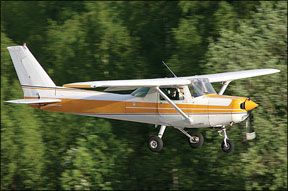If a
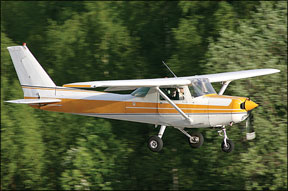
Although Cessna restarted piston-aircraft production in 1996, the 152 wasnt part of that revival. Over its eight years of production, 7584 examples of the 152, including A152 Aerobat and French-made Reims Aviation variants, were built. Today, the FAA shows more than 3800 copies presently wearing an N-number; many others are overseas, soldiering on alongside competing contemporaries from Piper (the PA-38-112 Tomahawk) and Beech (the Model 77 Skipper). More-modern competition from Diamond Aircrafts DA-20 Katana series and other manufacturers hasnt diminished their reputation as solid, basic, predictable trainers and personal airplanes.
For the potential owner in search of an inexpensive, tricycle-geared, all-metal, two-place way to get airborne, the 152 probably should be on the list. Of course, potential buyers need to know many 152s have had a hard life on the flight-training line, which could mean some chronic problems with items like nosewheel shimmy dampers, windows and doors, and interior components. Still, when properly flown and maintained, their engines are pretty bulletproof and parts are readily available.
As long as an owner doesnt mind taking some extra time-and not much luggage-to get from Point A to Point B, the 152 could be a good choice. But, like any other airplane, it has its quirks. Regardless, the potential buyer probably learned to fly in one of them, so its handling and other characteristics shouldnt come as a surprise.
History
To trace the 152s history, one needs to hark back all the way to the early years after World War II when Cessna brought its successful Models 120 and 140 to the
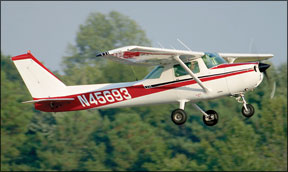
market. In 1956, 120/140 production having ceased in 1950, Cessna introduced its legendary 172. By 1959, the company saw it was a time for a new two-seat design: the all-metal, tricycle-gear Cessna 150. Powered by Continentals O-200 four-cylinder engine pounding out 100 hp, the 150 was created as a pure trainer to capitalize on what was then a hot growth market. Later, better-equipped versions carried the “Commuter” label and concept.
The first 150s look positively staid by modern standards. They had a straight, squared-off vertical stabilizer-same as the contemporary 172-and a turtledeck-style fuselage with no rear window. Like the 120/140 series before them, that design reduced rearward visibility.
Soon, the first of many changes began: The main gear struts were moved aft two inches in 1961, curing a tail-heavy tendency. Ten years later, tubular gear legs with a slightly wider track were added. In 1964, the rear window appeared and, of course, it needed a snappy marketing moniker, thus was born “OmniVision.” The stodgy straight tail went away in 1966, replaced by the swept-back tail and electric flaps replaced the manual “Johnson bar” mechanism.
The overall size of the airplane hasnt changed much but its max gross weight has. The 150 began life as a 1500-pound airplane, eventually grossing 1600 pounds before the 152 came out at 1670 pounds. Thats a substantial percentage increase, but much of it was offset by increases in empty weight.
Similarly, although the cabin remained small and tight, Cessna did improve its habitability somewhat. For example, the doors were bowed out slightly and the center console was narrowed, providing a bit more leg room side-to-side. In 1976, vertically adjustable seats were added.
The baggage compartment was also enlarged several times-most notably in 1964 along with OmniVision-and one option included a rear child seat. The baggage area could accommodate up to 120 pounds of kids and/or bags, so was suitable for a toddler and a daybag, but little else. In 1975, a larger fin and rudder were added.
A New Engine
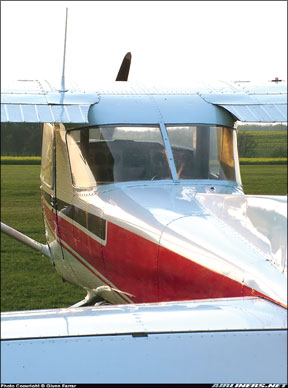
All of these evolutionary changes carried over to the 152, plus a few more. When red-tinted 80/87 gas became hard to find in the late 1970s, Cessna re-engined the 150, exchanging the venerable 100-HP O-200 for a 110-HP Lycoming O-235-L2C. The transplant provided more power and boosted the TBO from 1800 hours to 2000 hours and eventually 2400 hours.
Along with other changes-including a 28-volt electrical system, a lowered (for better visibility), one-piece cowling, a McCauley “gull-wing” prop, an oil cooler, wing flaps limited to 30 degrees and redesigned fuel tanks, the 150 morphed into the 152.
Sum total of changes? About 40 pounds more useful load than the original Cessna 150 featured, but fully 60 pounds less than a 1948 Cessna 140 could carry. The airplanes performance was about equal to the 150 it replaced.
Unfortunately, and despite best plans of both Cessna and Lycoming, the engine was susceptible to severe lead fouling when burning 100LL. Meanwhile, the 28-volt electrical system was a nuisance in a world accustomed to 14-volt trainers.
Worse, the 152 turned out to have some significant warts. Early models were hard to start because of weak spark and lack of priming capability. In response, Cessna added impulse coupling on both magnetos, plus direct priming for each cylinder.
Later models had a split cowl ing, so mechanics could get at the engine without removing the propeller, a sore point. In 1981, the Lyc got a spin-on oil filter as
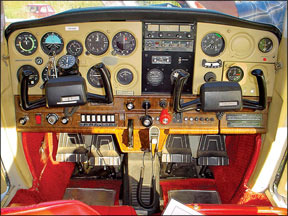
standard, an upgrade from the archaic screen. By 1983, Cessna and Lycoming had wrestled the lead-fouling issue into submission by replacing the O-235-L2C engine with the 108-hp -N2C variant, which the 152 carried for the rest of its production.
Versions
Despite the various model changes during the 150s production run, the 152s airframe changed little; trim and options packages also were limited. Aside from the standard model 152, there was a 152 II with an enhanced package of standard avionics and trim features. The 152 II with NavPac added dual nav/coms for IFR. The 152T was a standard option package aimed at flight schools, the “T” indicating “trainer” and not a sub-model.
Throughout much of the 150 and 152 production run, two main variants were available: The Aerobat and a seaplane conversion, the latter of which first appeared in 1967. The seaplane version was, by most accounts, a decent little water taxi. After adding floats and some beef ups in the fuselage structure, the seaplane version couldnt haul much and reportedly took a while to get off the water.
The A152 Aerobat was more popular. At the time, aerobatic mounts at the local FBO were all but unheard of and renting one for solo work was out of the question. The Aerobat changed all that. The A152 was certified for +6, -3g and had standard four-point harnesses, skylights and jettisonable doors, along with a checkerboard paint scheme and removable seat cushions to allow parachutes to be worn by the crew. About five percent of the 152s produced were Aerobats.
But alas, an Extra 300 it aint. For one thing, negative-G maneuvers arent permitted and, with two aboard, it lacks the power and punch of a true aerobatic thoroughbred. Probably with only one aboard, too. Any maneuvers requiring climbing back to altitude had best be performed judiciously, since gaining back that height will be a plodding process.
Also, the Aerobat has control yokes, not sticks. Aerobatic purists turn up their noses and sniff but more importantly, in performing some maneuvers-point rolls, for instance-the pilot not flying can expect to be pummeled by flailing elbows as the flying pilot whips the airplane through its paces.
But hey, whos complaining? How many models can do both workaday flight training and limited aerobatics? Naturally, the Aerobat commanded a price premium when new, about $1500 to $2000. On todays used market, the price Delta is higher, at around 30 percent.
Performance, Handling
By modern standards, the Cessna 152 still posts better-than-credible performance and handling traits. But what do we mean by modern standards?
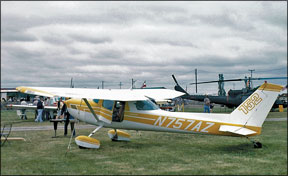
While its arguable, the only purely “modern trainer” sold in any numbers is Diamond Aircrafts DA20 Katana, which was the first strictly two-seat trainer of note to hit the market since the 152 went out of production. The FBOs and flightschools weve talked to report the Katanas sleek and sexy looks make it the airplane of choice for intro rides and initial training. That said, we know of students eschewing the 152/172 and DA-20 for the four-seat, low-wing, all-metal Piper Warrior.
Meanwhile, many pilots switch to a Cessna 152 or Cessna 172 to complete their training and for checkrides. Why? Frankly, the 152s higher weight gives it a more solid feel than the Katana has and, pricewise, 152s remain competitive to buy and operate. That said, the 152s handling and performance is predictable, but nothing special. In cruise and climb, it enjoys no real advantage over other popular trainers such as the Beech Skipper and Piper Tomahawk. Its a marginally better climber than the Katana A1, which carries an 80 hp Rotax engine.
Top speed for the 152 is given as 109 knots, same as the Tomahawk and two knots faster than the plodding Skipper. In the real world, of course, 152s go slower. Much slower. Owners tell us they flight plan for 90 to 95 knots, a more realistic expectation in our view.
In useful load, the 152 is essentially the same as the other popular trainers. With 528 pounds useful, it has a smidgen more than the Katana, a smidgen less than the Skipper and Tomahawk.
Where the 152 shines, however, is on load flexibility. Equipped with its optional fuel capacity of 39 gallons, the 152 has far better range with a single pilot than either the Tomahawk or the Skipper. With its miserly Rotax, though, the Katana A1 does quite a bit better on max range with one pilot.
Does this really matter? We think so. These aircraft are, after all, trainers, and one of the skills student pilots learn early on is how to run out of gas. In our view, the more gas aboard, the less likelihood of a fuel exhaustion event. Not that having an instructor aboard always makes a difference.
Handling is, well, predictable, which is just what Cessna intended and just whats wanted in a trainer. Control forces are relatively light and the airplane exhibits no nasty stall habits. In fact, its slow flight characteristics are so utterly benign that the 152 nearly qualifies as an STOL performer in stock condition.
The large flaps-even though limited to 30 degrees-are quite effective, even if they do generate quite a bit of nose-down trim moment. This is easily handled, although the control forces escalate somewhat. Students have to be taught to watch for abrupt nose-ups when applying full power for a go around, training that
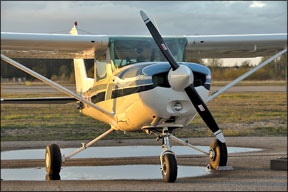
prepares them nicely to transition into the Cessna 172, which has the same characteristic.
Landing a 152 is easy enough to teach and learn, up to a point. And that point is often exceeded, since runway fender benders are the most common type of accident suffered by the 152 series.
The airplane is comfortable at an approach speed of 60 knots or slower, but it will seemingly tolerate higher speeds, since those draggy flaps bleed off excess airspeed in a heartbeat. Land it too fast, though, and it will bounce, a characteristic students demonstrate daily. (Any pre-buy should include a specific check of the logs for landing damage that included nosewheel work or firewall damage.)
Operators tell us the 152s runway performance is good, especially if the airplane is light. Its not as good when heavy on a hot day; it has been known to end up in the trees off the end of a short runway. Pop off the wheelpants-if it even has them-and the 152 will slosh through mud and high grass with the best of them.
Comfort, Ergonomics
Ask any flight instructor who has soldiered through hundreds of hours of time in the right seat to describe a Cessna 152 cockpit and the adjective “comfortable” probably wont come to mind.
The cabin is narrow so even pilots of moderate size will be bumping shoulders big time. There’s adequate leg room, thanks to seats that slide fore and aft but the seat height itself is quite low, compared to a Cessna 172 or a Warrior.
In 1979, thicker seat padding became standard but it helps only a little. Many owners have had the seats re-padded or carry a pillow or two to make them more tolerable. Noise level is quite high, due to the proximity of the cabin to the engine compartment but the advent of noise-cancelling headsets and intercoms has rendered this less of an issue.
Cabin ventilation in the 152 is via the standard Cessna pull vents in the wing roots, plus in most models the windows open for taxi and can also be opened in flight. During the winter, this can be a mixed blessing and some operators tape off the root vents to reduce drafts. Depending on how its been operated and cared for, an individual airplanes doors and windows may need some attention, lest they pop open at inopportune times.
Powerplant
When Cessna put the 110-HP Lycoming O-235-L2C in the 152, it did so with three goals in mind: First, solve the lead problem the then-new 100LL fuel was causing in the 150s venerable O-200.
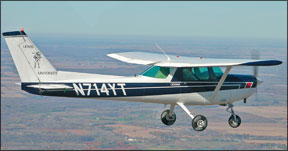
Second, boost the power a bit to increase the payload and offset the fact that the 150 gained 15 percent in empty weight since its introduction in 1959. Last, reduce noise. The higher compression O-235 Lyc delivered its 110 ponies at 2550 RPM rather than at the O-200s 2750 RPM.
Did Cessna hit the mark? Not really, say operators familiar with both airplanes. In its favor, the Lyc wasnt plagued by chronic starter adapter failures that made the Continental such a pain in the butt for mechanics. If the engine/prop combination was quieter, youd hardly notice. Owners complained about high parts prices for the O-235-including pistons and valves, the latter being sodium filled for improved cooling. And the lead problem? Still there, say owners. The O-235 accumulated lead deposits in every nook and cranny and lead fouling of plugs became such a problem that Champion developed a special extended-electrode spark plug for this engine, the REM37BY. Mechanics say even with careful leaning, the plugs must be removed and cleaned as frequently as every 25 hours.
“Otherwise,” one mechanic told us, “you can throw the plug away-it wont even be cleanable.” In Service Instruction 1418, Lycoming explains a procedure whereby cylinders can be blast-cleaned with walnut shells without removal for top-end overhaul. Prior to this, operators found that early tops were needed due to lead fouling of the cylinders.
With the 152s 1983 model year-toward the end of production-Cessna switched to the O-235-N2C in an apparent attempt to resolve the lead-fouling issue. The major difference between the two engine versions being a slightly lower compression ratio, horsepower dropped to 108. The change didnt fix the lead-fouling, forcing a generation of students and flight instructors to perfect their ground-leaning and plug-clearing techniques in an engine with less power.
Maintenance
One positive aspect of the Lycoming engine is its TBO- a whopping 2400 hours. If you can keep the thing from choking with lead, it may actually reach that impressive service limit. Overhaul prices have edged up in recent years, now averaging $17,000 or so, an amount approaching the complete airplanes value: With average Bluebook prices hovering in the mid-$20,000 range, try to find one with a low-time engine.
Owners who use the 152 for personal use-and many do-can count on literally years of service from the engine, if theyre operated enough to keep corrosion at
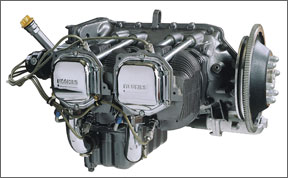
bay and leaned to avoid lead build-up. For a private owner, that ought to be doable.
In general, these are simple airframes and don’t require much maintenance. However, any airplane used extensively as a trainer-as most 150s and 152s have-should be inspected carefully for hard landing damage, especially in the nosegear/firewall bulkhead area.
The 152 series has what we would call an average list of ADs, none of which are particularly onerous or expensive. The major safety-related item is the seat-track AD, which helps prevent the seat from unlocking and sliding rearward. Most aircraft should have had this done long ago.
Owners report that annuals are thrifty-in the $400 to $600 range, depending on parts needed. Since the airplane is so simple, owner-assisted annuals are a good bet.
Mods, Organizations
A wide range of modifications approved under a supplemental type certificate (STC) are available for your 152. These include upgrades to a Lycoming O-320 or -360-providing much better runway and climb performance-auxiliary fuel tanks and even taildragger conversions.
Del-Air (559-784-9440) offers both engine upgrades and tailwheel mods. Bush Conversions (620-782-3851) also does tailwheel mods, though it no longer provides engine conversions. Horton, Inc. (800-835-2051, www.stolcraft.com), sells STOL kits for the 152, plus flap and aileron gap seals.
Air Mods N.W. (425-334-3030, www.airmodsnw.com) sells a power-boosting conversion for 152s. The STCd package includes high-compression pistons and a new Sensenich prop allowing the Lycoming O-235 to spin up to 2800 RPM and produce 125 HP.
Auxiliary fuel tanks, which will come in handy if you install a bigger, thirstier engine, are available in two basic flavors: mounted internally in both wingtips or in the baggage compartment. O&N Aircraft Modifications (570-945-3769, www.onaircraft.com) offers the in-cabin, baggage-compartment variety while Flint Aero (619-448-1551, www.flintaero.com) fits them inside the wing.
The two type clubs of note are the Cessna Pilots Association (CPA) and the Cessna 150-152 Club. The CPAs Santa Maria, Calif., operation is the font of all things Cessna and members rightly rave about its technical services. Contact CPA at 805-934-0493 or on the Web at www.cessna.org.
Meanwhile, the Cessna 150-152 Club is more tightly focused on Cessnas two-seat trikes. Its services include a monthly newsletter thats an excellent clearing house for information, parts, mods, maintenance and service tips. The club also conducts well-attended fly-ins. Contact the Cessna 150-152 Club at 805-461-1958 or www.cessna150-152club.com.
Owner Comments
If reliable and inexpensive flying is what you are looking for, it is hard to beat the Cessna 152. Put simply, the 152 is a plane I can afford to own and afford to fly. I have owned larger planes but would fly them less because of the operating expenses. In the 152, Im not as concerned about the low fuel burn of 5-6 gallons an hour and instead focus on flying.
Insurance costs about $650 per year, which is less than my car insurance. Annual inspections usually range in cost between $800 and $1000. Typically, the fixed annual expenses are under $2,000 per year.
One of the reasons the 152 suits me we’ll is that I often find myself flying alone. That reduced load contributes to the acceptable performance I get taking off at 5000 feet msl. I routinely climb out at 500-600 FPM on fall, winter and spring days. In the summer, however, it can be a challenge getting to 8000 feet. (I once had a controller in Colorado Springs question my transponders Mode C readout because the climb was so slow!)
I live on the east side of the Rockies in the foothills. Trips going east over the plains are easy. Trips going west into the mountains are something I rarely do. While it is considered an easy plane to fly, its lack of performance can get you in trouble if you don’t take it into consideration. Density altitude matters in a 152!
While Id like a Garmin 430, its hard to justify the expense in such an inexpensive plane. Our 152 is VFR only-I fly with the original avionics and a Garmin 196 handheld. This configuration has proven to be simple and functional in the many local and cross-country trips I have taken.
The 152 is not the best cross-country plane but it does just fine if you fit. My wife or one of my teenage daughters will often go with me on the cross-country trips and have few complaints about comfort. I find passengers over 510″ are uncomfortable on trips lasting much more than an hour. The primary complaint is that their legs are nearly straight out in front of them, as my seats do not elevate passengers very high off the floor.
I owned another 152 that had vertically adjustable seats. While the adjustable seats might be more comfortable, my mechanic would often need to make repairs to them during the annual inspection.
I have been a member of the Cessna Pilots Association (CPA) for many years. The CPA does not offer the classes for 152 owners that they do for some of the bigger birds. Even without the classes, though, CPA has proven to be a great resource for information and has been helpful whenever I have had specific questions. I have not felt “left out” as a 152 owner and definitely feel the membership fee is worth the benefit gained.
I have enjoyed the 152s I have owned over the years and would certainly recommend one to anyone looking for something reliable and inexpensive, albeit with minimal performance.
Tom Lynch
Fort Collins, Colorado

